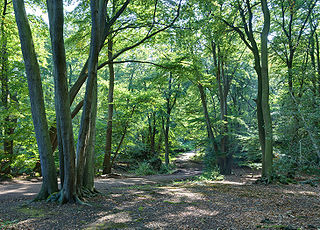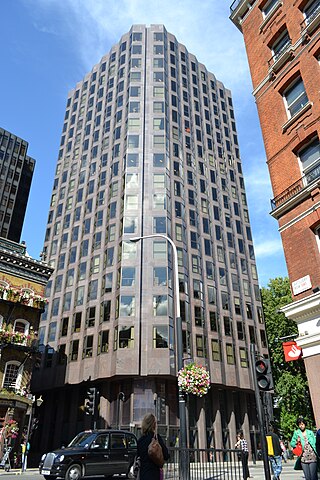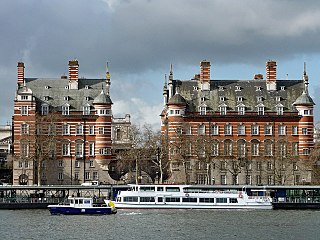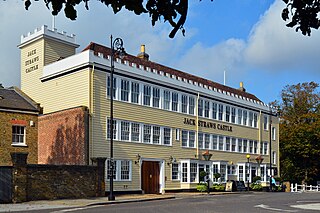
Epping Forest is a 2,400-hectare (5,900-acre) area of ancient woodland, and other established habitats, which straddles the border between Greater London and Essex. The main body of the forest stretches from Epping in the north, to Chingford on the edge of the London built-up area. South of Chingford the forest narrows, and forms a green corridor that extends deep into east London, as far as Forest Gate; the forest's position gives rise to its nickname, the Cockney Paradise. It is the largest forest in London.

The Worshipful Company of Carpenters is a livery company of the City of London. The Carpenters were traditionally different from a fellow wood-crafting company, the Worshipful Company of Joiners and Ceilers, in that carpenters utilised nails while joiners used adhesives to attach wood.

King William Street is a street in the City of London, the historic nucleus and modern financial centre of London. It is a two-way street linking Lombard Street, at its northern end, with London Bridge, which marks the start of the start of the A3 route to Portsmouth.

Horse Guards Parade is a large parade ground off Whitehall in central London. It is the site of the annual ceremonies of Trooping the Colour, which commemorates the monarch's official birthday, and the Beating Retreat.

Lesnes Abbey is a former abbey, now ruined, in Abbey Wood, in the London Borough of Bexley, southeast London, England. It is a scheduled monument, and the abbey's ruins are listed at Grade II by Historic England.

Windsor House is an office building in Victoria Street, City of Westminster, London, England. It was built in 1973 by R. Seifert & Partners,

The Norman Shaw Buildings are a pair of buildings in Westminster, London, overlooking the River Thames. The buildings were designed by the architects Richard Norman Shaw and John Dixon Butler, between 1887 and 1906. They were originally the location of New Scotland Yard between 1890 and 1967, but from 1979, have been used as parliamentary offices and have been named Norman Shaw North and South Buildings, augmenting limited space in the Palace of Westminster.

All Saints Pastoral Centre is a complex of buildings at London Colney on the southern outskirts of St Albans, Hertfordshire, England. It was built as a convent for the Anglican Society of All Saints Sisters of the Poor.

The Punch Bowl, at 41 Farm Street, Mayfair, is a London public house, dating from circa 1750. It is listed as Grade II by English Heritage. It is a Georgian building and, although altered over the years, retains many period features including a dog-leg staircase, internal cornicing and dado panelling.

The Royal Pavilion Tavern, commonly known as the Pavilion Tavern or Pav Tav and since February 2022 as The Fitz Regent, is a pub in the centre of Brighton, part of the English coastal city of Brighton and Hove. Converted from a house into the Royal Pavilion Hotel in the early 19th century, its original role soon changed from a hotel to a pub, in which guise it remained until its closure in September 2019. It reopened under its new name, but still in the ownership of the Mitchells & Butlers chain, on 13 February 2022. The building was also used as a court for several years early in its history, and prominent local architect Amon Henry Wilds was responsible for its redesign as a hotel and inn. English Heritage has listed the building at Grade II for its architectural and historical importance, and it stands within a conservation area.

The Holly Bush is a Grade II listed public house in Holly Mount, Hampstead, London, NW3.

Holborn Bars, also known as the Prudential Assurance Building, is a large red terracotta Victorian building on the north side (138–142) of Holborn in Camden at the boundary of the City of London, England. The block is bounded by Holborn to the south, Brooke Street to the west, Leather Lane to the east and Beauchamp Street to the north. It is currently occupied by De Vere Venues and also the London office of English Heritage at 1 Waterhouse Square.

The Sun and 13 Cantons is a Grade II listed public house at 20 Great Pulteney Street, Soho, London W1.

A statue of Sir Joshua Reynolds stands in the Annenberg Courtyard of Burlington House, off Piccadilly in the City of Westminster, London, England. Reynolds was the first president of the Royal Academy, who occupy the main wing of Burlington House.

Jack Straw's Castle is a Grade II listed building and former public house on North End Way, Hampstead, north-west London, England close to the junction with Heath Street and Spaniards Road.

Riding House Street is a street in central London in the City of Westminster.

The Fleece Hotel, Westgate Street, Gloucester is a timber framed building dating from the 15th century, which incorporated a 12th-century stone undercroft. The building is part grade I and part grade II listed with Historic England.

Old Doctor Butler's Head is a pub in Mason's Avenue, London EC2. The pub was named after the physician William Butler, a doctor at the court of James I. Butler is credited with inventing the medicinal drink Dr Butler’s purging ale, which became popular in 17th-century England.

The Intrepid Fox was a pub at 97–99 Wardour Street, Soho, London, established in 1784 by the publican Samuel House, who named it after the prominent British Whig statesman Charles James Fox. The pub was located on the corner of Wardour Street and Peter Street.

The Old Bank of England is a public house at 194 Fleet Street, where the City of London meets the City of Westminster.





















